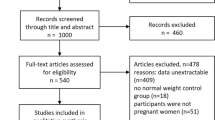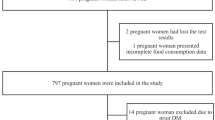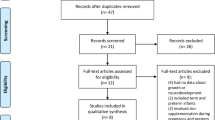Abstract
Background/Objective:
Low birthweight (LBW) and intrauterine growth restriction are linked with maternal nutritional status during pregnancy, and maternal supplementation with multiple micronutrients (MMNs) is reported to increase birthweight. Responses to MMN, however, might be modified by maternal nutrition.
Subjects/Methods:
To examine the differential effects of maternal nutritional status on birthweight responses to prenatal MMN supplementation, data from the Supplementation with Multiple Micronutrient Intervention Trial, a cluster-randomized trial in Indonesia was analyzed. Birthweight outcomes of 7001 infants whose mothers received iron/folic acid were compared with 7292 infants whose mothers received MMN. The modifying effects of maternal short-term nutritional status (mid-upper arm circumference (MUAC) and long-term nutritional status (height) on the birthweight response to MMN supplementation were assessed.
Results:
For women with higher MUAC (⩾23.5 cm), MMN increased mean birthweight by 33 g (95% confidence interval (CI): −1 to 66, P=0.06) and significantly reduced LBW by 21% (relative risk: 0.79, 95% CI: 0.64–0.99, P=0.04). The modifying effect of MUAC on mean birthweight, LBW and small for gestational age was significant. There was no evidence of a modifying effect of maternal height on the response to MMN.
Conclusions:
Supplementation with MMN in pregnancy increased birthweight, but maternal nutritional status modified this response, with infants born to women with better short-term nutrition having greater birthweight response.
This is a preview of subscription content, access via your institution
Access options
Subscribe to this journal
Receive 12 print issues and online access
$259.00 per year
only $21.58 per issue
Buy this article
- Purchase on Springer Link
- Instant access to full article PDF
Prices may be subject to local taxes which are calculated during checkout

Similar content being viewed by others
References
Alexander GR, Himes JH, Kaufman RB, Mor J, Kogan M (1996). A United States national reference for fetal growth. Obstet Gynecol 87, 163–168.
Arredondo M, Martinez R, Nunez MT, Ruz M, Olivares M (2006). Inhibition of iron and copper uptake by iron, copper and zinc. Biol Res 39, 95–102.
Barker DJP (2007). The origins of the developmental origins theory. J Intern Med 261, 412–417.
Bartels DB, Kreienbrock L, Dammann O, Wenzlaff P, Poets CF (2005). Population based study on the outcome of small for gestational age newborns. Arch Dis Child 90, F53–F59.
Bhutta ZA, Haider BA (2008). Maternal micronutrient deficiencies in developing countries (comment). Lancet 371, 186–187.
Bonamy A, Norman M, Kaijser M (2008). Being born too small, too early, or both: does it matter for risk of hypertension in the elderly? Am J Hypertens 21, 1107–1110.
Brigelius-Flohe R, Traber MG (1999). Vitamin E: function and metabolism. FASEB J 13, 1145–1155.
Chard T, Penney G, Chalmers J (2001). The risk of neonatal death in relation to birth weight and maternal hypertensive disease in infants born at 24-32 weeks. Eur J Obst Gynecol Reprod Biol 95, 114–118.
Dimitrov NV, Meyer C, Gilliland D, Ruppenthal M, Chenoweth W, Malone W (1991). Plasma tocopherol concentrations in response to supplemental vitamin E. Am J Clin Nutr 53, 723–729.
Fall CHD, Fisher DJ, Osmond C, Margetts BM, Maternal Micronutrient Supplementation Study Group (2009). Multiple micronutrient supplementation during pregnancy in low-income countries: a meta-analysis of effects on birth size and length of gestation. Food Nutr Bull 30, S533–S546.
Fawzi WW, Msamanga GI, Urassa W, Hertzmark E, Petraro P, Willett WC et al. (2007). Vitamins and perinatal outcomes among HIV-negative women in Tanzania. N Engl J Med 356, 1423–1431.
Filmer D, Pritchett L (1998). Estimating Wealth Effects Without Expenditure Data or Tears: with an Application to Educational Enrollments in States of India: Policy Research Working Paper. The World Bank, vol. 1994.
Godfrey K, Robinson S, Barker DJP, Osmond C, Cox V (1996). Maternal nutrition in early and late pregnancy in relation to placental and fetal growth. BMJ 312, 410–414.
Kaestel P, Michaelsen KF, Aaby P, Friis H (2005). Effects of prenatal multimicronutrient supplements on birth weight and perinatal mortality: a randomised, controlled trial in Guinea-Bissau. Eur J Clin Nutr 59, 1081–1089.
Kinare AS, Natekar AS, Chinchwadkar MC, Yajnik CS, Coyaji KJ, Fall CHD et al. (2000). Low midpregnancy placental volume in rural Indian women: a cause for low birth weight? Am J Obstet Gynecol 182, 443–448.
Meas T, Deghmoun S, Armoogum P, Alberti C, Levy-Marchal C (2008). Consequences of being born small for gestational age on body composition: an 8-year follow-up study. J Clin Endocrinol Metab 93, 3804–3809.
Osrin D, Vaidya A, Shrestha Y, Baniya RB, Manandhar DS, Adhikari RK et al. (2005). Effects of antenatal multiple micronutrient supplementation on birthweight and gestational duration in Nepal: double-blind, randomised controlled trial (see comment). Lancet 365, 955–962.
Ozaltin E, Hill K, Subramanian SV (2010). Association of maternal stature with offspring mortality, underweight, and stunting in low- to middle-income countries. JAMA 303, 1507–1516.
Pandolfi C, Zugaro A, Lattanzio F, Necozione S, Barbonetti A, Colangeli MS et al. (2008). Low birth weight and later development of insulin resistance and biochemical/clinical features of polycystic ovary syndrome. Metabolism 57, 999–1004.
Roberfroid D, Huybregts L, Lanou H, Henry MC, Meda N, Menten J et al. (2008). Effects of maternal multiple micronutrient supplementation on fetal growth: a double-blind randomized controlled trial in rural Burkina Faso. Am J Clin Nutr 88, 1330–1340.
Shah PS, Ohlsson A, Knowledge Synthesis Group on Determinants of Low Birth Weight and Preterm Births (2009). Effects of prenatal multimicronutrient supplementation on pregnancy outcomes: a meta-analysis (see comment). CMAJ 180, E99–E108.
SUMMIT Study Group, Shankar AH, Jahari AB, Sebayang SK, Aditiawarman, Apriatni M et al. (2008). Effect of maternal multiple micronutrient supplementation on fetal loss and infant death in Indonesia: a double-blind cluster-randomised trial (see comment). Lancet 371, 215–227.
Sunawang, Utomo B, Hidayat A, Kusharisupeni, Subarkah (2009). Preventing low birthweight through maternal multiple micronutrient supplementation: a cluster-randomized, controlled trial in Indramayu, West Java. Food Nutr Bull 30, S488–S495.
Thame M, Osmond C, Bennett F, Wilks R, Forrester T (2004). Fetal growth is directly related to maternal anthropometry and placental volume. Eur J Clin Nutr 58, 894–900.
Traber MG, Traber MG (2007). Vitamin E regulatory mechanisms. Annu Rev Nutr 27, 347–362.
Victora CG, Adair L, Fall C, Hallal PC, Martorell R, Richter L et al. (2008). Maternal and child undernutrition: consequences for adult health and human capital (erratum appears in Lancet 2008;371(9609):302). Lancet 371, 340–357.
WHO. Statistical Classification of Diseases and Related Health Problems 10th Revisions. Tabular list. World Health Organization: Geneva 1994.
WHO (1995). Physical status: the use and interpretation of anthropometry. Report of a WHO Expert Committee. World Health Organ Tech Rep Ser 854, 1–452.
Yasmin S, Osrin D, Paul E, Costello A (2001). Neonatal mortality of low-birth-weight infants in Bangladesh. Bull World Health Organ 79, 608–614.
Zeng L, Cheng Y, Dang S, Yan H, Dibley MJ, Chang S et al. (2008). Impact of micronutrient supplementation during pregnancy on birth weight, duration of gestation, and perinatal mortality in rural western China: double blind cluster randomised controlled trial.[see comment]. BMJ 337, a2001.
Acknowledgements
The SUMMIT was supported by funds from the Turner Foundation, the United Nations International Children's Emergency Fund, the Centre for Health and Human Development, and the United States Agency for International Development-Indonesia (Grant no. 497-G-00-01-00001-00). SKS PhD program is supported by the Australian Leadership Awards provided by the Australian Agency for International Development.
Author information
Authors and Affiliations
Corresponding author
Ethics declarations
Competing interests
The authors declare no conflict of interest.
Rights and permissions
About this article
Cite this article
Sebayang, S., Dibley, M., Kelly, P. et al. Modifying effect of maternal nutritional status on the impact of maternal multiple micronutrient supplementation on birthweight in Indonesia. Eur J Clin Nutr 65, 1110–1117 (2011). https://doi.org/10.1038/ejcn.2011.97
Received:
Revised:
Accepted:
Published:
Issue Date:
DOI: https://doi.org/10.1038/ejcn.2011.97
Keywords
This article is cited by
-
Early life opportunities for prevention of diabetes in low and middle income countries
BMC Public Health (2012)



